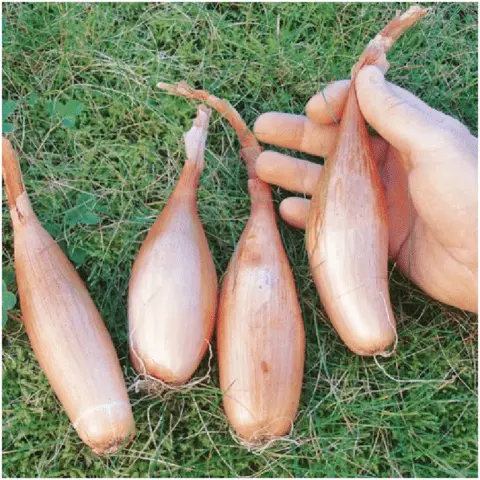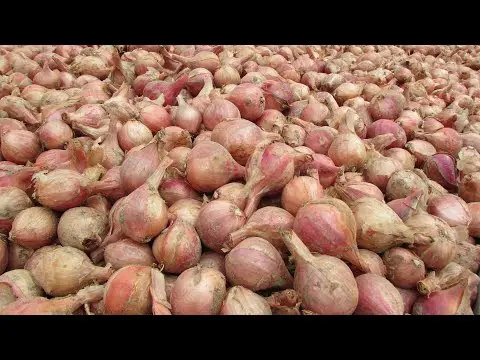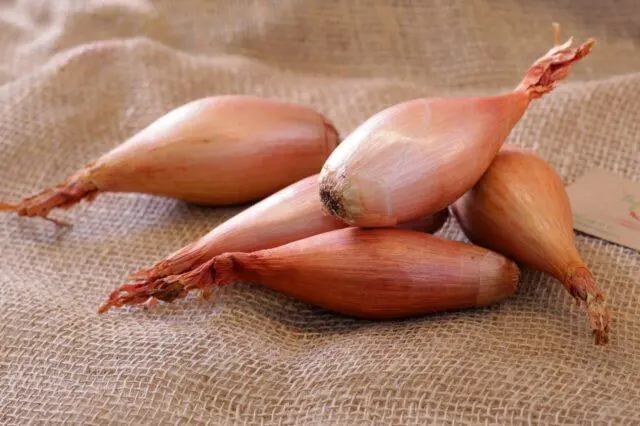Contents
- The chemical composition and calorie content of shallots
- Taste onion shallot
- What are the benefits of shallots
- How to use shallots in folk medicine
- How shallots are eaten and where they are added
- What can you substitute for shallots?
- Why are shallots so expensive
- Harm of shallots and contraindications
- Conclusion
The benefits and harms of shallots are associated with its rich chemical composition. The pulp contains a lot of sugars and at the same time the bitterness and causticity characteristic of the onion species are completely absent. Therefore, such a vegetable is great for baking, frying in butter, pickling. It can be a good addition or an independent side dish,
The chemical composition and calorie content of shallots
The composition of shallots includes vitamins, minerals and other valuable compounds:
- proteins;
- carbohydrates (sugars);
- cellulose;
- vitamins of group B (B1, B3, B5, B6, B9), C (ascorbic acid), A;
- essential oils;
- trace elements (zinc, iodine, iron, copper, molybdenum, chromium, selenium, cobalt, vanadium, calcium, nickel).
Only the composition of shallots includes such valuable and rare elements as selenium, chromium, vanadium and cobalt. They provide great benefits to the body. For example, selenium regulates the thyroid gland, strengthens the immune system, improves brain function. Chromium provides metabolism and maintenance of normal weight. Vanadium is a part of blood cells and bone tissue.
The calorie content of shallots per 100 grams is 72 kcal per 100 g. This is almost twice as much as onions (40 kcal), due to the high sugar content. Nutritional value of shallots per 100 g:
- proteins – 2,5 g;
- fats – 0,1 g;
- carbohydrates – 16,8

Shallots are much smaller than onions and have an elongated shape.
The bulk of the mass (almost 80%) is water, the rest (20%) is dry matter. Among other valuable food components of shallots, fiber is also worth highlighting – 3,2 g per 100 g (almost 13% of the daily requirement).
Taste onion shallot
Shallots taste only slightly reminiscent of onions. The main difference is the complete absence of bitterness, causticity. Therefore, such a product can also be consumed raw, without prior blanching (keeping in boiling water).
Another feature is a noticeable sugar content, which is associated with a rather high content of carbohydrates. At the same time, the sweet note is unobtrusive, and the taste is generally spicy. The benefits of shallots are associated with its high juiciness (especially compared to ordinary onions). It’s also nice that it doesn’t have a strong smell. Therefore, shallots do not “clog” the flavors of other products. It is especially valuable in salads.
The benefit of shallots is that they are great for all kinds of dishes. It does not contain caustic substances that are released into the air and lead to tearing. It is very simple to peel the bulbs, for example, you can put them in boiling water for 10 minutes, and then the skin will come off by itself. But in order not to worsen the taste and not destroy the vitamins, it is better to remove the husk with a knife.
What are the benefits of shallots
The benefits of shallots are due to its chemical composition. The product contains many vitamins, so it has a healing effect on the body:
- prevention of vitamin deficiency;
- prevention of eye diseases;
- normalization of blood pressure;
- improvement of immunity;
- prevention of SARS and other infections;
- stimulation of digestive processes;
- removal of slags.

Shallots are especially useful when eaten fresh.
How to use shallots in folk medicine
The use of shallots, associated with its chemical composition, allows the vegetable to be used in folk medicine:
- Juice is used for compresses that disinfect wounds, abrasions and promote their healing.
- The benefits of a vegetable for the treatment of angina, SARS have been proven. In this case, you can dilute it with a little water and gargle.
- Also, raw shallots are recommended to be consumed in small quantities with a decrease in appetite. It stimulates digestion and therefore benefits health.
How shallots are eaten and where they are added
The main purpose of shallots is culinary use. It is often put in salads, but is also used for cooking, for example, fried with meat. The benefits of the product are undoubted – when preparing a number of dishes, it is better to use it instead of onions:
- with avocado;
- in salads with cucumbers, radishes and other vegetables;
- for pickling (pickles are made from onions);
- baking, including with honey, butter, dried fruits;
- when fried with butter.
Baking
For baking, shallots are peeled, seasoned, placed on a foil greased with oil, and sent to the oven for 20 minutes. The result is a delicious and unusual dish with an original taste. Its benefit is that baked onions can be served not only as an appetizer, but also as a side dish.
Roasting
Onions can also be fried. Shallot contains more sugar, so it caramelizes better – it becomes covered with a pleasant blush. If you cook a dish in good butter or ghee, it will turn out not only tasty, but also fragrant. Suitable as an addition to meat or a side dish (for example, buckwheat porridge).
Pickling
The use of shallots is that such onions can be used for pickling, and not only other vegetables (cucumbers, tomatoes), but also on their own. 15 onions are placed in a liter jar, poured with water, salt and vinegar and sent to marinate for several weeks. Sugar is optional, as the onion itself is quite sweet.
What can you substitute for shallots?
It is important to understand that shallot is unique in its own way – most often it cannot be replaced with onion or red. For example, when preparing salads, it is best to use this particular vegetable.

In some dishes, shallots cannot be replaced with onions due to the difference in taste and aroma.
The benefits of the product are undeniable, especially if you cook a salad, a vegetable snack or bake onions in the oven. Although in some cases it is permissible to use the usual onions. This is especially appropriate when frying or marinating meat in onion juice. The product is still thermally processed, so there will not be much difference in taste.
It is not put in chicken broths, borscht, pickles and other similar dishes. The benefits of onions, which are appropriate in most soups, are obvious here.
Why are shallots so expensive
Shallots provide great benefits for culinary dishes and are even used in traditional medicine, are in stable demand. But on an industrial scale, culture is not grown. The plant is whimsical and requires some care. Therefore, companies have to attract a lot of workers, which significantly increases the cost of the final product.
In Our Country, culture is rarely grown and mainly in the southern regions and the Black Earth region. Recently, varieties suitable for cultivation in Siberia have been bred. Perhaps the culture will gradually spread to different regions of the country.
Harm of shallots and contraindications
If you eat a vegetable in small quantities every day, it will not harm your health. Shallot has not so many contraindications, however, it should not be used in the presence of such diseases:
- constipation;
- ulcers of the digestive tract;
- pancreatitis;
- colitis;
- kidney disease;
- liver pathology.
Pregnant and lactating women can use shallots in moderation. The benefits of the fresh product are especially noticeable. Without heat treatment, it retains all the vitamins.
Conclusion
The benefits and harms of shallots have been studied for a long time, but in Our Country this vegetable is not so common. Due to its rich taste and chemical composition, it is used not only for food, but also for the treatment of certain diseases.









